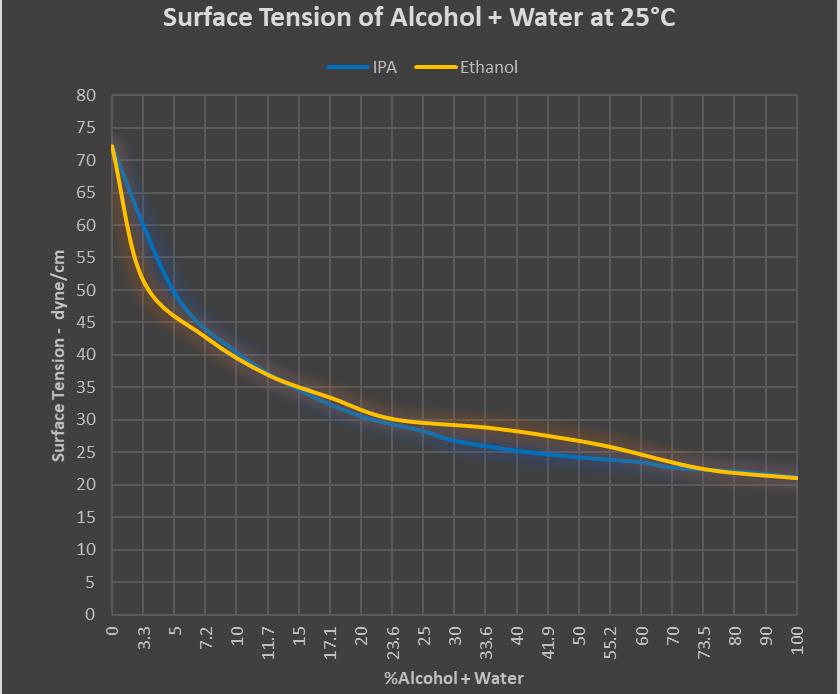@drkingfish @recklesskelly @whart @lewm
I initially thought it would be best to resolve the selection of ethanol and the specific concentration of 22.000% before discussing other matters. And, I thought the best and easiest way was to prepare a very accurate and detailed graphs demonstrating the transition points. One being extremely significant and the others less so important.
And, that is exactly what I had done, however, I am unable to post this graph or a pdf. I contacted the Administrator on how to proceed, however, I have not as yet received a response. So, I am going to ask you to prepare your own graphs on either graph paper, or quadrille paper, or a simple sheet of 8.5 x 11 paper. I will provide you with only the 4 key points and describe how to prepare the graph to see the significant slopes related to the 22.000% value.
If you choose the 11 inch vertical side as you y-axis representing the Surface Tension at 20 degrees C and expressed as dynes per centimeter into 75 segments, and then select the horizontal 8.5 inch bottom to represent the x-axis indicating the percentage of Ethanol from 0% to 95.6% at 20 degrees C in parts by weight into 100 segments, we can begin.
At 0.00% Ethanol on the x-axis, the corresponding Surface Tension is: 72.72 dynes per centimeter on the y-axis.
At 22.00% Ethanol on the x-axis, the corresponding Surface Tension is: 30.28 dynes per centimeter on the y-axis.
At 41.50% Ethanol on the x-axis, the corresponding Surface Tension is: 27.59 dynes per centimeter on the y-axis.
At 95.60% Ethanol on the x-axis, the corresponding Surface Tension is: 26.63 dynes per centimeter on the y-axis.
(I will explain the reason why the values are to two decimal places rather than my original three decimal formulation a bit later).
You can immediately see the very steep slope between 0.00% Ethanol concentration and the 22.00% concentration. At 41.50% Ethanol you notice a slight decline, and, at 95.60% the additional decline is even less significant. Many people, would have considered only one inflection point, but, I choose not to deviate from established mathematical guidelines.
From 0.00% Ethanol to 22.00% represents a drop in Surface Tension of a phenomenal 42.44 dynes per centimeter.
Going to than 41.50% represents a rather meaningless drop of only an additional 2.70 dynes per centimeter. And going the max of 95.60% represents a drop of only 0.93 dynes per centimeter.
Now, I hope EVERYONE on the Planet understands the selection and significance of 22.000%
This data is available from many reference sources such as "The Handbook of Chemistry and Physics", "Lange’s Chemical Handbook", etc. However, I choose the most comprehensive study of alcohols and water starting at 20 degrees C to 50 degrees C, at 5 degree. C intervals, and the Surface Tension done at 20 C. The slopes of the 25 C graph are identical only the values are different. They presented their representations in two decimal places, and, that is why I conformed to their numbers. Other resources clearly establish 22.000% , that is why in is in the formulation.
I do not take any credit for any of the values stated. The credit need to be given to Dr. Gonzalo Vazquez, Dr. Estrella Alvarez and Jose M. Navaza that was recorded in "The Journal of Chemical Engineering". All products were supplied by Merck Laboratories and all solutions were prepared to 4 decimal places on identical Sartorius Analytical Balances, but the results were chosen to be represented to only 2 decimal places.
Now @mijostyn we have established your reasoning for your selection of BAK. Thank you for making that clear, and, in your case, it is TRULY a VERY SIGNIFICANT matter, and one that can not be ignored. You asked if the BAK is detrimental in any way. The only detrimental effect is the resultant residue, but more significantly, your level of 7.600% parts by weight is "off the charts" so to speak, which now leads to a more significant level of residue resultant.
But most importantly you need something that will not only will kill the mildew and mold, but also something that will prevent it from further happening.
I have the PERFECT solution for you, and, it is something with which you are very familiar. The additive is: 2-phenoxyethanol. It is a hand antiseptic for surgeries, and is in some hand antiseptics, and, is used as a preservative in IV medications and vaccines.
A 1.00% addition is over kill. A 0.500% represents a 87.5% potency of a 1.00% addition. (It is non-linear). Therefore if you were to use 0.500% of 2-phenoxyethanol, it would be much less than the 7.600% BAK you were using. But you would have NO residue, and the effectiveness is even difficult to compare because the 2-phenoxyethanol is so much more effective.
"I wold like to continue but my "medical demon" is summoning me." The rest will have to wait until Wednesday.
In the interim, find out how easy it is for you to obtain the 2-phenoxyethanol. It is commonly used in labs as well, my wife has some here at home, but. Its’ best before date has long passed. It is still good and effective but not to the same degree. Good Luck! Till later…


